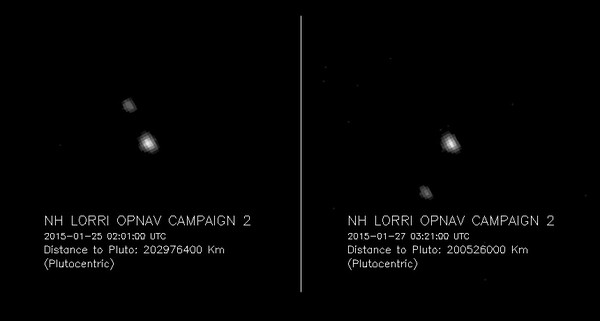As the New Horizons spacecraft continues speeding toward its rendezvous with Pluto this summer, it has just sent back new photos of the dwarf planet and its largest moon, Charon, it was reported. The occasion is all the more special because yesterday was the late astronomer Clyde Tombaugh’s birthday, who discovered Pluto in 1930. Tombaugh, who had been born on Feb. 4, 1906, died in 1997.
“This is our birthday tribute to Professor Tombaugh and the Tombaugh family, in honor of his discovery and life achievements — which truly became a harbinger of 21st century planetary astronomy,” said New Horizons Principal Investigator Alan Stern. He added, “These images of Pluto, clearly brighter and closer than those New Horizons took last July from twice as far away, represent our first steps at turning the pinpoint of light Clyde saw in the telescopes at Lowell Observatory 85 years ago, into a planet before the eyes of the world this summer.”
Back in Tombaugh’s time, sending a spacecraft to Pluto was just a fantastical dream, but now it’s about to finally come true later this summer when New Horizons flies by Pluto on July 14. New Horizons will be the first spacecraft to ever visit this tiny world. The best images we still have, from the Hubble Space Telescope, can only show a small point of light with faint and blurry markings on the surface just barely visible. But soon, there will be crisp, high-resolution images to look at, our first view of this far-away place.
As Hal Weaver, New Horizons project scientist at the Johns Hopkins University Applied Physics Laboratory (APL) in Laurel, Maryland, stated, “Pluto is finally becoming more than just a pinpoint of light. LORRI has now resolved Pluto, and the dwarf planet will continue to grow larger and larger in the images as New Horizons spacecraft hurtles toward its targets. The new LORRI images also demonstrate that the camera’s performance is unchanged since it was launched more than nine years ago.”
The newest images were taken on Jan. 25 and Jan. 27, 2015 using the Long-Range Reconnaissance Imager (LORRI). New Horizons is still more than 126 million miles (203 million kilometers) away from Pluto, but these images are the first to be taken during the approach phase of the mission. At that distance, Pluto and its largest moon Charon still appear as little more than bright spots, but from here on out, the images will keep getting better.
Hundreds more images will be taken over the next few months, which will help mission scientists refine the estimate of the spacecraft’s distance to Pluto. They can be used for course-correction maneuvers as New Horizons gets close to its target; the first such maneuver is scheduled for March 10.
New Horizons was launched on Jan. 19, 2006, and has already traveled more than 3 billion miles. It is now approaching Pluto at 31,000 miles per hour. That’s fast for any spacecraft, but it still takes a long time to reach something so far in the outer reaches of the Solar System as Pluto is. The only other spacecraft which have traveled farther are Voyager 1 and Voyager 2, launched in the 1970s.
Pluto is the second-most massive dwarf planet, after Eris, and the largest known object in the Kuiper Belt. It is smaller than our own Moon, yet has five known moons of its own, the largest of which is Charon. Pluto also possesses a very thin atmosphere of nitrogen, methane, and carbon monoxide. Because the atmosphere is so thin and of course being so far from the Sun, Pluto is extremely cold, about 43 K (−230 °C). The atmosphere is also thought to partially condense onto the surface when Pluto is farthest from the Sun, but then sublimate again when it is closest, in a repeating cycle.
The best maps so far, from the Hubble Space Telescope, reveal apparent seasonal surface changes, but these won’t be understood much better until New Horizons can take a much closer look. Spectroscopic analysis of Pluto’s surface reveals it to be composed of more than 98 percent nitrogen ice, with traces of methane and carbon monoxide.
Despite the extreme conditions, some scientists have also suggested that there might be a subsurface ocean inside Pluto, similar to ones in small icy moons like Europa and Enceladus, among others. Such a thing would have been thought impossible not that long ago, but it now seems that oceans and seas inside icy moons and dwarf planets may actually be quite common. New Horizons should provide more data on whether or not Pluto possesses one as well. It has even been speculated that there may be geysers similar to the ones on Saturn’s icy and watery moon Enceladus.
Whatever New Horizons finds, it will be our first close-up look at this fascinating little world. One may wonder how would Tombaugh feel if he could have witnessed this historic encounter?
“My dad would be thrilled with New Horizons,” said Annette Tombaugh, Clyde Tombaugh’s daughter, of Las Cruces, New Mexico. “To actually see the planet that he had discovered and find out more about it, to get to see the moons of Pluto… he would have been astounded. I’m sure it would have meant so much to him if he were still alive today.”
Indeed, he would be proud.















